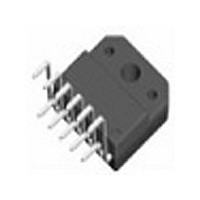LM3886TF National Semiconductor, LM3886TF Datasheet - Page 22

LM3886TF
Manufacturer Part Number
LM3886TF
Description
92F299
Manufacturer
National Semiconductor
Datasheet
1.LM3886TF.pdf
(24 pages)
Specifications of LM3886TF
Operational Class
Class-AB
Audio Amplifier Output Configuration
1-Channel Mono
Output Power (typ)
68x1@4OhmW
Audio Amplifier Function
Speaker
Input Offset Voltage
10@±28VmV
Input Bias Current
1uA
Total Harmonic Distortion
0.03@4Ohm@60W%
Single Supply Voltage (typ)
18V
Dual Supply Voltage (typ)
±12/±15/±18/±24V
Power Supply Requirement
Single/Dual
Power Dissipation
125W
Unity Gain Bandwidth Product (typ)
8MHz
Rail/rail I/o Type
No
Power Supply Rejection Ratio
120dB
Single Supply Voltage (min)
20V
Single Supply Voltage (max)
84V
Dual Supply Voltage (min)
±10V
Dual Supply Voltage (max)
±42V
Operating Temp Range
-20C to 85C
Operating Temperature Classification
Commercial
Mounting
Through Hole
Pin Count
11 +Tab
Package Type
TO-220
Amplifier Class
AB
No. Of Channels
1
Output Power
68W
Supply Voltage Range
20V To 84V
Load Impedance
4ohm
Operating Temperature Range
-20°C To +85°C
Amplifier Case Style
TO-220
Rohs Compliant
No
Lead Free Status / RoHS Status
Not Compliant
Available stocks
Company
Part Number
Manufacturer
Quantity
Price
Part Number:
LM3886TF
Manufacturer:
CN/如韵
Quantity:
20 000
Company:
Part Number:
LM3886TF/NOPB
Manufacturer:
AVX
Quantity:
40 000
Part Number:
LM3886TF/NOPB
Manufacturer:
TI/德州仪器
Quantity:
20 000
www.national.com
Definition of Terms
applies with the output transistors conducting alternately at a
high enough frequency that the peak capability of neither
transistor is exceeded.
Power Bandwidth: The power bandwidth of an audio am-
plifier is the frequency range over which the amplifier voltage
gain does not fall below 0.707 of the flat band voltage gain
specified for a given load and output power.
Power bandwidth also can be measured by the frequencies
at which a specified level of distortion is obtained while the
amplifier delivers a power output 3 dB below the rated out-
put. For example, an amplifier rated at 60W with ≤ 0.25%
THD + N, would make its power bandwidth measured as the
difference between the upper and lower frequencies at which
0.25% distortion was obtained while the amplifier was deliv-
ering 30W.
Gain-Bandwidth Product: The Gain-Bandwidth Product is
a way of predicting the high-frequency usefulness of an op
amp. The Gain-Bandwidth Product is sometimes called the
unity-gain frequency or unity-gain cross frequency because
the open-loop gain characteristic passes through or crosses
unity gain at this frequency. Simply, we have the following
relationship: A
Assuming that at unity-gain (A
GBWP, then we have the following: GBWP = A
This says that once fu (GBWP) is known for an amplifier,
then the open-loop gain can be found at any frequency. This
is also an excellent equation to determine the 3 dB point of a
closed-loop gain, assuming that you know the GBWP of the
device. Refer to the diagram on the following page.
CL1
x f
1
= A
CL2
x f
CL1
2
(Continued)
= 1 or (0 dB)) fu = fi =
CL2
x f2
22
Biamplification: The technique of splitting the audio fre-
quency spectrum into two sections and using individual
power amplifiers to drive a separate woofer and tweeter.
Crossover frequencies for the amplifiers usually vary be-
tween 500 Hz and 1600 Hz. “Biamping” has the advantages
of allowing smaller power amps to produce a given sound
pressure level and reducing distortion effects produced by
overdrive in one part of the frequency spectrum affecting the
other part.
C.C.I.R./A.R.M.:
Literally: International Radio Consultative Committee
This refers to a weighted noise measurement for a Dolby B
type noise reduction system. A filter characteristic is used
that gives a closer correlation of the measurement with the
subjective annoyance of noise to the ear. Measurements
made with this filter cannot necessarily be related to un-
weighted noise measurements by some fixed conversion
factor since the answers obtained will depend on the spec-
trum of the noise source.
S.P.L.: Sound Pressure Level — usually measured with a
microphone/meter combination calibrated to a pressure level
of 0.0002 µBars (approximately the threshold hearing level).
where P is the R.M.S. sound pressure in microbars.
(1 Bar = 1 atmosphere = 14.5 lb/in
Average Responding Meter
S.P.L. = 20 Log 10P/0.0002 dB
01183316
2
= 194 dB S.P.L.).






